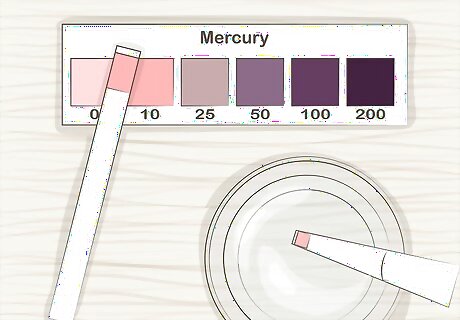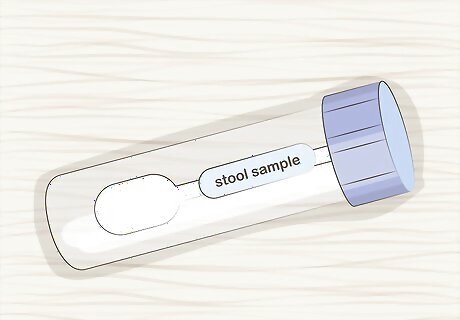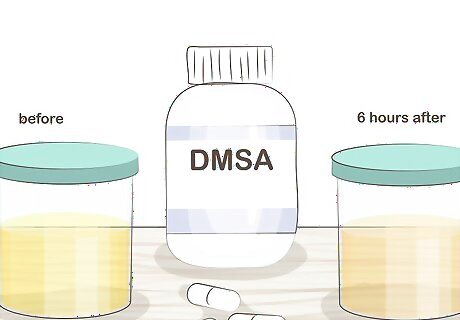
views
X
Trustworthy Source
Centers for Disease Control and Prevention
Main public health institute for the US, run by the Dept. of Health and Human Services
Go to source
Fortunately, detecting mercury is pretty straightforward, whether you're testing water, soil, air, or even the human body.
Testing Water, Soil, and Air

Buy a water testing kit online if you think your water contains mercury. Fill a cup with water you suspect may be contaminated and follow the instructions of the test. These tests are reasonably straightforward to do. However, if your sample tests above the limit, it’s probably worth sending the sample to a professional lab for further analysis. The limit for safe mercury presence in water is 0.002 mg/L.

Collect an air sample if you're concerned about mercury in your living space. Checking for mercury in a home is really important for people looking at buying a new house. When you are walking through, simply open up a ziplock bag and drag it through the air. You will need to send the results away to a lab to get an analysis of how much mercury is actually present. Look for your nearest lab online. You can buy kits that give you results at home, but these don’t show you how much mercury is present, they just show you whether or not there is any present at all. Mercury is only a problem once it gets above toxic levels. The safe level for mercury in the air is anything below 20 μg/m3 or 20 parts per million (20 ppm).

Test your soil if your land is near an industrial area or if you plan to farm. Search online for a laboratory near you that tests soil samples for the presence of mercury. Contact the lab to get instructions on how they would like for you to send the soil to them. They may send you specific tools and instructions for the collection of your soil. There is no way to test for mercury in your soil at home. You must send the test away and wait for the results. Even if you aren’t a farmer, if you live in an urban area and you’re concerned that there might be mercury in your soil, have a test done just to be sure. Mercury that is found in soil is usually the result of prior industrial activity on the land.
Performing Tests for Human Mercury Poisoning

Get a urine test if you want a cheap and quick option. Take a urine sample as soon as possible after any suspected exposure. If your local clinic doesn’t offer urine tests for mercury, you may have to go to a hospital. A toxic level of mercury for blood and urine is anything greater than 50 ng/mL. Organic mercury does not pass out of the body through urine which means that, for example, if you have been poisoned by eating too much fish, it will not show up in this test. The most common way people get mercury poisoning is by eating too much fish/shellfish. However, you can also get poisoned if you are exposed to vapors at an industrial workplace, such as a smelting plant.

Have a blood test if you want a little more certainty. Mercury only stays in the blood for a few days, so make sure you get a sample soon after your suspected exposure. The sample needs to be sent to a laboratory for analysis so you may have to wait a few days for your results. Blood tests provide really accurate analysis of the presence of organic mercury in your body. Organic mercury is found in red blood cells, which is why blood tests give the most accurate reading of this form of mercury.

Collect a stool sample if you think the poisoning occurred a while ago. Look online for websites that send you a collection kit. You then need to send the sample back to them and they will do the analysis for you. You can also go to a hospital and inquire about their testing process. Stool samples provide evidence of both organic and inorganic mercury. This is compared to urine and blood tests which each only provide evidence of one type of mercury. Stool samples also show evidence of long-term exposure to mercury. This may be missed by urine and blood tests, as both of those systems are continually flushing toxins from your body.

Retrieve a hair sample if you can afford a more expensive option. Testing the hair is an effective test for long-term exposure to organic mercury. Be prepared for the fact that this test is complicated and, as such, is quite expensive. This will most likely be ordered by your doctor as a definitive measure. Hair tests are very accurate, but because of their cost they really only get used in cases where there needs to be a certainty. Toxic elements may be 200-300 times more highly concentrated in hair than in blood or urine which makes hair an ideal sample to test.

Take a DMSA challenge if all other options have failed. This is a last resort and is absolutely definitive on indicating if you have toxic levels of mercury in your body. Talk to your doctor about whether you need to take this test, as they will order it for you. The way you take this test is by collecting a regular urine sample, then taking the DMSA drug. You will then collect another urine sample 6 hours later. At this point, any mercury in your body will be much more detectable. DMSA works by filtering out all the heavy metals in your body that aren't mercury. DMSA also mobilizes stored mercury from tissue in your body to make it more present in urine. Never take this test without medical supervision.
Checking for Physical and Mental Indicators of Mercury Poisoning

Consider whether or not you feel particularly nervous or anxious. Make sure you factor in your feelings from over a period of at least a week. Try to remember any period of time where you felt nervous or anxious, but there wasn’t a definitive reason for it. Increased anxiety and nervousness are some of the first signs of mercury poisoning. Obviously, there are a wide range of causes of these feelings so this isn't a definitive indicator, but they are an initial marker.

Check your hands to see if you are experiencing tremors. Tremors are an uncontrollable shaking of your hands when you try to hold them still. You can easily check this by holding your hands flat in front of you, and trying to keep them as still as possible. Most people can hold their hands fairly still, but it does differ from person to person, so don’t be too concerned if you can’t hold your hands completely still. These symptoms come as a result of the effect that mercury has on your body’s nervous system. As the mercury levels get higher in your body, the impact on your nervous system gets more intense.

Think about if you have noticed mood swings more than usual. Try to think about times where you have had a drastic change in your mood without any particular reason. Over time, your mood swings will get more severe so this is something to consider as well. Mood swings come as a result of mercury affecting the neurological functions within your body. Some other mental-health related symptoms to look out for may be periods of depression, panic attacks, short-temper, and basically any extreme or intense feeling.

Determine if your breathing is regular and free from difficulty. Be sure to try breathing like you normally would to see if you notice any differences. Try to see if you can hear any wheezing when you breathe deeply, or if you struggle to take deep breaths. Mercury affecting your respiratory system is a symptom that develops much further into mercury poisoning. If you’re experiencing other symptoms and you notice issues breathing as well, it’s definitely time to consider getting tested for mercury poisoning.

Check your body for muscle weakness and numbness. This is a symptom that you obviously notice fairly quickly as you will feel these sensations in your body. Look for a tingling feeling in your hands, as this is where the symptom generally originates. Numbness and muscle weakness is a serious symptom that only really occurs after mercury has built up to a very toxic level in your body. Some other serious symptoms to look out for are nausea, vomiting, metallic taste in your mouth, lack of motor skills, and an inability to walk straight.

Determine if you’ve had fish in your recent diet. Eating fish that have been contaminated with mercury is the largest cause of mercury poisoning in humans. Halibut and fresh tuna are high in mercury, but it can be found in canned tuna as well. Limit your intake of fish if you want to reduce your risk of poisoning.















Comments
0 comment